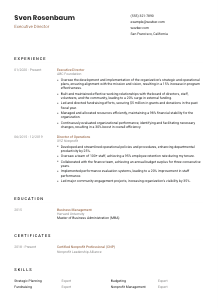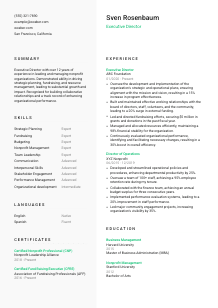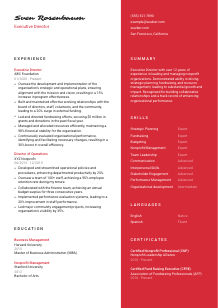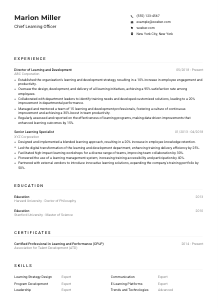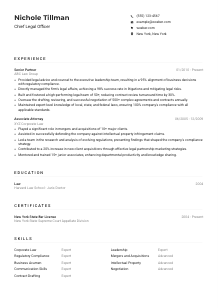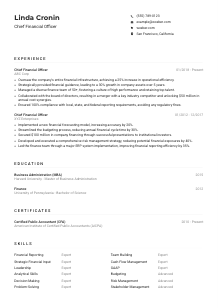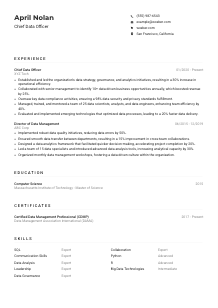Executive Director Resume Example
Steering organizations, but your resume feels directionless? Navigate this Executive Director resume example, charted with Wozber free resume builder. Realize how effortlessly you can fuse your leadership compass with job coordinates, ensuring your career trajectory aligns with your visionary course!

How to write an Executive Director Resume?
Hello, aspiring Executive Director! You're on the brink of applying for a role that's crucial in driving the vision and operations of a nonprofit. Crafting a standout resume is your first step in showcasing your ability to lead with vision, passion, and efficiency. Using Wozber's free resume builder, which is armed with an ATS-friendly resume template and an ATS resume scanner, you'll master the art of aligning your resume with your career aspirations.
Ready to shape a resume that unlocks the door to your dream role? Let's embark on this empowering journey together!
Personal Details
Your personal details are the cornerstone of your resume, introducing who you are in a professional context. Crafting this section with care is crucial for the Executive Director position, ensuring it's not just correct but strategic. Let's tailor this section to make you instantly identifiable as the leadership powerhouse you are.
1. The Name is Your Flag
Your name is your brand's flag, flying high above the details of your resume. Ensure it's in a captivating, readable font, slightly larger than the rest of your text, signaling your presence with authority and professionalism.
2. Job Title Alignment
Include your targeted position, "Executive Director," beneath your name. This assertive alignment with the job title forms an immediate connection in the recruiter's mind, subtly affirming you're a perfect fit for the role.
3. Essential Contact Info
Your contact information is your bridge to potential opportunities. Ensure it includes a professional email and your most direct phone number. A minor typo here could mean a lost opportunity—double and triple-check this section!
4. Geo-tagging Yourself
By listing "San Francisco, California" in your contact details, you mirror a crucial requirement from the job description, thereby easing any relocation concerns at a glance and demonstrating your readiness for the position.
5. Digital Presence
If you have a LinkedIn profile or a professional website (possibly a portfolio showcasing your achievements and projects), including it here builds a broader picture of your professional existence. It adds depth to your resume and provides a platform for your narrative to continue beyond the confines of this document.
Takeaway
The Personal Details section is your resume's firm handshake. It's the first impression, setting the stage with a professional and role-aligned introduction. Make sure it's meticulously crafted, ensuring every detail from your name to your LinkedIn profile speaks of your eligibility and readiness for the Executive Director role.





Experience
In your journey to becoming an Executive Director, your experience is your map, displaying the path you've navigated through the nonprofit leadership landscape. It's where you connect your unique story with the specific demands of the job. Let's ensure your experience section speaks volumes about your capability to lead with vision.
- Oversee the development and implementation of the organization's strategic and operational plans, ensuring alignment with the mission and vision, resulting in a 15% increase in program effectiveness.
- Built and maintained effective working relationships with the board of directors, staff, volunteers, and the community, leading to a 20% surge in external funding.
- Led and directed fundraising efforts, securing $5 million in grants and donations in the past fiscal year.
- Managed and allocated resources efficiently, maintaining a 98% financial stability for the organization.
- Continuously evaluated organizational performance, identifying and facilitating necessary changes, resulting in a 30% boost in overall efficiency.
- Developed and streamlined operational policies and procedures, enhancing departmental productivity by 25%.
- Oversaw a team of 100+ staff, achieving a 95% employee retention rate during my tenure.
- Collaborated with the finance team, achieving an annual budget surplus for three consecutive years.
- Implemented performance evaluation systems, leading to a 20% improvement in staff performance.
- Led major community engagement projects, increasing organization's visibility by 35%.
1. Reflect on Job Requirements
Dive deep into each job requirement, identifying how your past roles align. Responsibilities such as overseeing strategy development and fund-raising efforts are not just bullet points but chapters of your leadership story. Reflect on your past to draw a clear, compelling line to this role.
2. Chronology and Clarity
Structure your experience in a reverse-chronological order, spotlighting your evolution in the nonprofit sector. From your latest achievement of securing $5 million in grants at ABC Foundation to enhancing community engagement at XYZ Nonprofit, each role should narrate your growing leadership and impact.
3. Highlighting Impactful Achievements
Accomplishment statements are where you shine, quantifying your achievements to demonstrate tangible impact. Did you lead a campaign that expanded the donor base by 25%? Or perhaps you streamlined operations to cut costs by 15%? These are the narratives that underline your executive prowess.
4. Numbers Tell Stories
Quantify your successes wherever possible. Whether it's a 30% boost in organizational efficiency or managing a team that achieved a 95% employee retention rate, these figures offer a measurable testament to your leadership and operational effectiveness.
5. Relevancy is Key
Filter your experiences through the lens of the job you're aiming for. Every role and project listed should directly speak to your capacity to meet and exceed the Executive Director position's demands, leaving no doubt in the hiring manager's mind about your fit for the role.
Takeaway
The Experience section of your resume is your narrative arc, tracing your journey and growth in the nonprofit sector. Each entry should be a strong, concrete example of how you're not just fit for the role of Executive Director but destined for it. Focus on impactful, quantifiable achievements to demonstrate your readiness and capacity for leadership.
Education
Your educational background is the bedrock upon which your career is built. For an Executive Director, it's not just about listing degrees; it's about showcasing how your academic journey has prepared you for leadership in the nonprofit sector.
1. Meeting the Minimum
Start with the essentials, ensuring your education meets or exceeds the job description's requirements. A Master of Business Administration from Harvard University and a Bachelor of Arts in Nonprofit Management from Stanford University are not just educational credentials; they are indicators of your deep commitment to nonprofit leadership.
2. Simple, Yet Informative Structure
Keep the structure of your education section clean and straightforward – name of the degree, the field of study, the institution, and graduation year. This clarity is not just for aesthetics; it's for the ATS (Applicant Tracking System) to easily interpret and verify your qualifications.
3. Aligning Degree Details
Ensure your degrees directly reflect the fields mentioned in the job description. The titles of your degrees should not leave room for doubt that you are academically prepared to take on the responsibilities of an Executive Director in a nonprofit environment.
4. Relevant Courses and Achievements
While your degrees are impressive, don't overlook the value of specific courses or academic honors that align with the job. Were you the president of a relevant student organization, or did you complete a significant thesis on nonprofit management? These details weave depth into your educational narrative.
5. Continuous Learning
Never stop learning. If you've taken part in workshops or additional certifications relevant to nonprofit management or leadership besides your degree, mention them. Continuous learning showcases your commitment to staying abreast of industry trends and developments.
Takeaway
Your Education section is more than a list of schools and degrees; it's a testament to your preparedness for the challenging role of an Executive Director. Ensure it precisely reflects your academic achievements, aligned with the nonprofit sector's demands, and demonstrates your pursuit of lifelong learning and excellence.
Certificates
Certificates are your badges of honor, showcasing your dedication to professional development and expertise in key areas of nonprofit management. They corroborate your skills and knowledge, adding another layer of credibility to your resume.
1. Key Requirement Identification
Begin with the specific certifications the job post highlights, such as the Certified Nonprofit Professional (CNP) or Certified Fund Raising Executive (CFRE). These are not just nice-to-haves; they're a testament to your commitment and expertise in the field.
2. Relevance is Everything
Prioritize listing certifications that are most relevant to the Executive Director role. Remember, it's about quality, not quantity. Each certification should tell a part of your professional development story, leading to why you're the best fit for this role.
3. Dates Matter
Including the date you obtained a certification is crucial, especially if they have an expiration or require ongoing education to maintain. This information demonstrates your dedication to staying current and ahead in your field.
4. Continuous Growth
Nonprofit leadership is an ever-evolving field, requiring a continuous commitment to learning and growth. Stay proactive in seeking out and obtaining certifications that will bolster your knowledge and resume, keeping you competitive and informed.
Takeaway
Your Certificates section should not just be a list but a narrative of your ongoing professional development and dedication to excellence in nonprofit management. Make it robust and reflect your commitment, ensuring each certificate aligns with and propels you toward your goal of becoming an Executive Director.
Skills
Your skills section is a concise showcase of the competencies that qualify you for the Executive Director role. It's a curated list that should clearly communicate your proficiency in strategic planning, fundraising, budgeting, and leadership, among others.
1. Extract and Match
Dig into the job description, listing both explicit and implied skills. Align these with your competencies, ensuring a match that's both genuine and compelling. Terms like ‘Strategic Planning' and ‘Fundraising' aren't just buzzwords but critical capabilities you've honed over years of dedicated service.
2. Prioritize Pertinence
While you might possess a broad range of skills, focus on those directly relevant to an Executive Director's duties. Skills in ‘Nonprofit Management', ‘Team Leadership', and ‘Budgeting' directly respond to the core requirements of the job description, resonating with the crucial demands of the role.
3. Structure and Presentation
Aim for clarity and impact in presenting your skills. Using an ATS-friendly resume format ensures that your skills are easily discernible to both the human eye and AI, making your resume as impactful as possible.
Takeaway
Your Skills section should function as a mirror, reflecting the job description's requirements in your own professional repertoire. Treat this section as a focused, impactful showcase of why you're not just competent but stellar for the Executive Director role. Make it clear, concise, and compelling.
Languages
In an increasingly globalized world, your language skills can set you apart, even in leadership roles within the nonprofit sector. They underscore your ability to communicate effectively, bridge cultural divides, and extend the reach of your organization.
1. Job Specification Alignment
First, identify if the role specifically calls for proficiency in any languages. For the Executive Director position, a "Command of the English language is essential." State your proficiency upfront, establishing your communication foundation.
2. Highlight Additional Languages
If you're proficient in languages beyond the specified requirements, list them. Your fluency in Spanish or any other language can be a unique asset, reflecting your ability to engage with diverse communities and stakeholders.
3. Honesty in Proficiency
Clearly state your level of proficiency using terms like 'Native', 'Fluent', 'Intermediate', and 'Basic'. This clarity sets realistic expectations and showcases your honesty – a valued trait in any leader.
4. Understand the Role's Scope
Consider the geographical and demographic scope of the nonprofit's operations. If it involves international work or diverse communities, emphasizing your multilingual skills could significantly strengthen your application.
5. Embrace Global Connectivity
Every language you speak is a portal to another culture, another way of seeing the world. It's not just about being understood but about understanding – a critical skill for any Executive Director working within the rich tapestry of global and local communities.
Takeaway
Language skills are more than just a line on your resume; they're a testament to your ability to communicate, understand, and engage in a multicultural world. Highlight your linguistic proficiency, making sure it aligns with the job's requirements and adds value to your role as an Executive Director, a global leader in the making.
Summary
The summary is the narrative heart of your resume, offering a succinct glimpse into your career and the unique impact you've made. It's your moment to emphasize how your experiences, skills, and visions align with the role of an Executive Director.
1. Capture the Role's Core
Before diving into writing, breathe in the essence of the Executive Director role. Your summary should resonate with the depth and breadth of your experience in leading nonprofit organizations towards growth and impact.
2. A Strong Opening
Start with a powerful introduction that encapsulates your professional identity. "Executive Director with over 12 years of experience in leading and managing nonprofit organizations" immediately positions you as a seasoned leader, setting the tone for the narrative that follows.
3. Speak to Key Requirements
Weave in specifics from the job description that align with your achievements. Mention your proven record in strategic planning, fundraising, and budgeting, highlighting your exceptional ability to lead diverse teams towards achieving the organization's mission.
4. Brevity and Impact
Keep your summary concise yet impactful. Aim for 3-5 powerful lines that draw a clear picture of your capabilities and the distinctive value you bring to the Executive Director role. This section sets the stage; make every word count.
Takeaway
Your summary is your professional herald, capturing the essence of your career and ambition in the context of the Executive Director role. Make it a powerful, concise declaration of your vision and readiness for leadership. This is your first opportunity to engage the hiring manager's interest, so craft it with care, making sure it echoes the core values and requirements of the job.
Embracing Your Executive Director Journey
Congratulations on sculpting a resume that merges your narrative with the vision of an Executive Director. Armed with Wozber's ATS-friendly resume template and ATS resume scanner, you've mastered the art of tailoring your resume to meet the nuances of your dream role. Your resume is not just a document; it's a testament to your leadership journey, poised to make a lasting impact. Let it be the beacon that guides you to your next grand achievement in the non-profit realm.
Your dedication, expertise, and visionary leadership are what the world needs. Go forth, inspire, and transform. Your journey as an Executive Director begins now.

- Bachelor's degree in Business Management, Nonprofit Management, or a related field.
- Master's degree preferred.
- Minimum of 10 years of progressively responsible experience in nonprofit management, with at least 5 years in an executive-level role.
- Proven track record in strategic planning, fundraising, and budgeting within a nonprofit organization.
- Exceptional leadership, communication, and interpersonal skills, with the ability to inspire and lead a diverse team.
- Professional certifications in nonprofit management, such as the Certified Nonprofit Professional (CNP) or Certified Fund Raising Executive (CFRE), are an asset.
- Command of the English language is essential.
- Must be located in or willing to relocate to San Francisco, California.
- Oversee the development and implementation of the organization's strategic and operational plans, ensuring alignment with the mission and vision.
- Build and maintain effective working relationships with the board of directors, staff, volunteers, and the community to drive the organization's success.
- Lead and direct fundraising efforts, including grant writing, donor stewardship, and special events.
- Manage and allocate resources efficiently to maintain the organization's financial stability.
- Continuously evaluate organizational performance, identifying areas for improvement and facilitating necessary changes.





